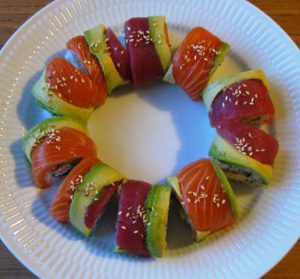 The Japanese do not eat as much sushi as many in European believe.
The Japanese do not eat as much sushi as many in European believe.
The Japanese are very fond of sushi. In Japan, sushi accounts for less than 15% of Japanese cuisine due to the fact that Japanese cuisine has many unique styles to offer.
The Japanese cuisine spans just Kaiseki which is a dinner consisting of 7-12 small dishes, tempura, yakitori, stews, grilled dishes, deep fried dishes, noodles and much more.
In the Japanese kitchen there are also styles that suit everything from a busy weekday to a weekend night with a party. Many Tokyo restaurants are decorated in such a way that there is also seating if you come alone.
Some of these styles are offered on the courses I hold.
Japanese noodle soup for beginners
Traditional Japanese cooking class for beginners
_
Zoë has held sushi courses and cooking classes for A. P. Moller – Maersk, Hugo Boss Nordic, Novo Nordisk, Novartis, Velux, Gorrissen Federspiel, Beierholm revision, Elbek & Vejrup and many more.







